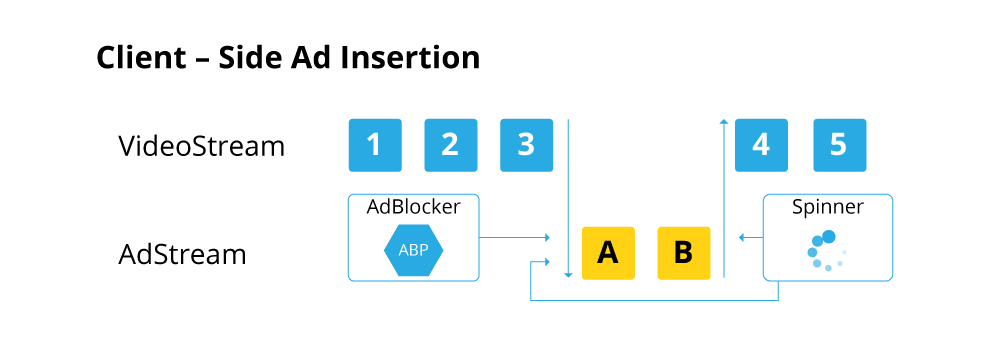In our last blog, we touched upon the growing importance and adoption of video advertisement monetization in OTT platforms. Let us know take a look at some of the current methodologies is use for video ad insertions.
This is done in two ways – CSAI (Client-Side Ad Insertion) and SSAI (Server-Side Ad Insertion).
However, before we take a deeper dive into the technical aspects of these ad insertion methods, let us have a brief understanding of how the Video player – the most important entity in the video delivery ecosystem – works.
There is a lot wrapped up in the word "playback!" A video player's UI is the first thing that most people associate with playback since it's what they see and interact with the most whenever they watch video, but that's just the tip of the playback iceberg.
Player controls, performs checks and has algorithms for decision making and exposes various other vital aspects of playback beyond just the controls themselves. Its functionality includes features like subtitles and captions, programmatic APIs for controlling playback, hooks for things like client-side analytics, ad insertion, and much more.
In video streaming the actual content is broken down in smaller individual segment files and transported over the network to the requesting video player. Therefore, we need to have a mechanism (or metadata) that the player can read and understand the segments it is receiving. It is the job of the manifest files (aka, the playlist files) to tell the player where to find the segment files. The master manifest file is the first point of contact for the player. When the player loads the master manifest it observes all the details of the various stream resolutions and segments that are available and picks the best one. The manifest file also has details about the ad insertions that need to be done embedded within the metadata. Now that we know what manifest file is, let us return to CSAI and SSAI.
In a CSAI-flow, advertisements are managed and added directly onto the end-user’s device. From a delivery point-of-view, content and ads are separated, with the video player running content and ads independent of each other. The player is also capable of switching between the two as needed.
- For streaming the digital content, the video player should download the manifest and read CSAI related metadata (Ad slots, Ad Server etc).
- Pre-roll advertisements will start playing before the video starts.
- The fragment will be paused when the video reaches a specific ad marker.
- The Video Player will then issue an API call as a request to the Ad server.
- The server will respond with a metadata tag (eg: VAST) which comprises all the information related to the ad.
- The player reads the information and streams the advertisement.
- After completion, the video continues from the point where it was paused before the advertisement.

In an SSAI-flow, ads are directly stitched to the streaming video metadata on the server side at the last moment. The content and advertisements are closer related to each other, allowing for a smoother playback and transition.
- In an SSAI-flow, advertisements are directly stitched to the streaming manifest on the server side at the last moment. The content and advertisements are closer related to each other, allowing smoother playback and transitions.
- This way of working is comparable with traditional linear television.
- The main difference between broadcast advertising and SSAI is that the latter allows advertisements to be targeted towards individual end-users.

Both Client-Side Ad Insertion and Server-Side Ad Insertion have their advantages and disadvantages. CSAI is generally easier to set-up, but comes with a generally lower fill-rate due to ad blockers and platform limitations.

SSAI is a bit more complex to set up, and slightly more expensive, but it provides an overall smother experience.
The typical Ad platform software components of an OTT service provider looks like below

There are series of steps involved in delivering ads on an OTT platform for an Ad campaign of an Advertiser. The mode of delivery can differ on the choice basis of the ad protocol, relevant to the platform and its compatible OTT devices.
- In the first step, the target audience grouping is done for a particular campaign. This list of users is drawn from the platform database and user analytics data and is further filtered by some qualitative metrics based on content consumption, reach, popularity ,geo, language, age etc.
- In the next step, the focus is on the launch of the ad campaign by integrating/configuring the ad campaign management system to the Ad aggregation & delivery systems to start the ad delivery.
- Next the campaign is made live and the ad is being played to the audience, and tags are used as an instruction to the media player of the OTT app on how to play the video & Ads to the viewer and tracking data is sent back to the Ad aggregation & delivery systems.
- In the final step, reports concerning the outcome/views of the ad are consolidated from Ad aggregation & delivery systems & supporting financial software and transferred to the advertiser for invoicing.
In our next piece, we would be diving into the details of each of the components of the Ad platform in greater detail.




